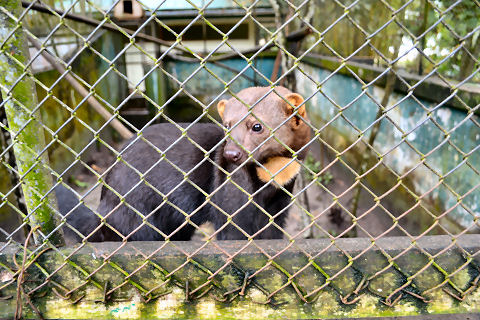I travelled to Iquitos in Peru to visit Luis - a Peruvian vet I had worked with on the Nicaraguan Veterinary Project He works at a small zoo about 15km outside Iquitos
 |
| Suburbs of Iquitos!! |
The zoos animal inhabitants reflect this proximity to the jungle - nearly all the animals come from there.


The zoo is not without it's problems - Iquitos has a great deal of poverty and revenue from paying customers is low - it's less than £1 for an adult to get in! The zoo is owned by the local government but with lots of social problems in Iquitos the zoo is way down the priority list. The end result sadly is a place where a lot of animals are kept in far from optimal conditions. But there is awareness that things are not as they should be - a few days before I arrived there was an article about the zoo in the local newspaper. Luis also is all too aware of the poor conditions and is doing his best to help improve facilities and welfare - for that I admire him


It had been over 25 years since I had visited a zoo and it was difficult to see the animals in small cages - especially the big cats - the jaguars and pumas - pacing back and forth...
 |
| Big Cats Small Cages |

On a more positive note the day before I left I got an incredible opportunity to help a couple of the cats They were the Jaguarundi - Lola and Lila


Although they are one of the smaller members of the cat family weighing in at just 10kg it doesn't make them any easier to handle. An adult Jaguarundi being quite able to kill a human being! So it was a couple of very brave keepers who netted the cats for us.
 |
| Netting the Jaguarundi |
 |
| Transport to the treatment room |
 |
| Under GA |
 |
| Lola's fractured canine - note the discolouration due to seepage on necrotic pulp into the dentine canals |
 |
| This is the other jaguarundi's tooth - Lila - the very tip was chipped off - a close up photo revealed pulpal exposure - the black spot in the centre |
 |
| Luis doing the ultrasonic clean |
 |
| Raising the flap to expose the tooth root |
 |
| Tooth extracted and flap sutured |
 |
| Lola's canine - her tooth was fractured higher up the crown - note discolouration and large pulp exposure - very little significant apical pathology though |
 |
| Lila's canine - her tooth was fractured just at the tip - little dicolouration and tiny pulp exposure - huge apical pathology - she was in pain with this condition |
 |
| Luis waking the Jaguarundi up |
 |
| Greta the Giant River Otter - personality plus! Check her feet and tail - no wonder she can swim fast with that equipment! |
 |
| On the move with a mouthful of fish! |
 |
| Linda - one of the smaller otters but twice as cheeky!! |
 |
| Doing what she does best! |
 |
| The Macaws imitating each other! |
 |
| 2 toed sloth |
I would like to thank the staff at Complejo Quistococha for welcoming me there - especially mi amigo Luis and Evelyn the biologist
| Luis on a house visit!! |
 |
| Evelyn with Yuri |
 |
| The staff preparing dinner for the animals |






























































